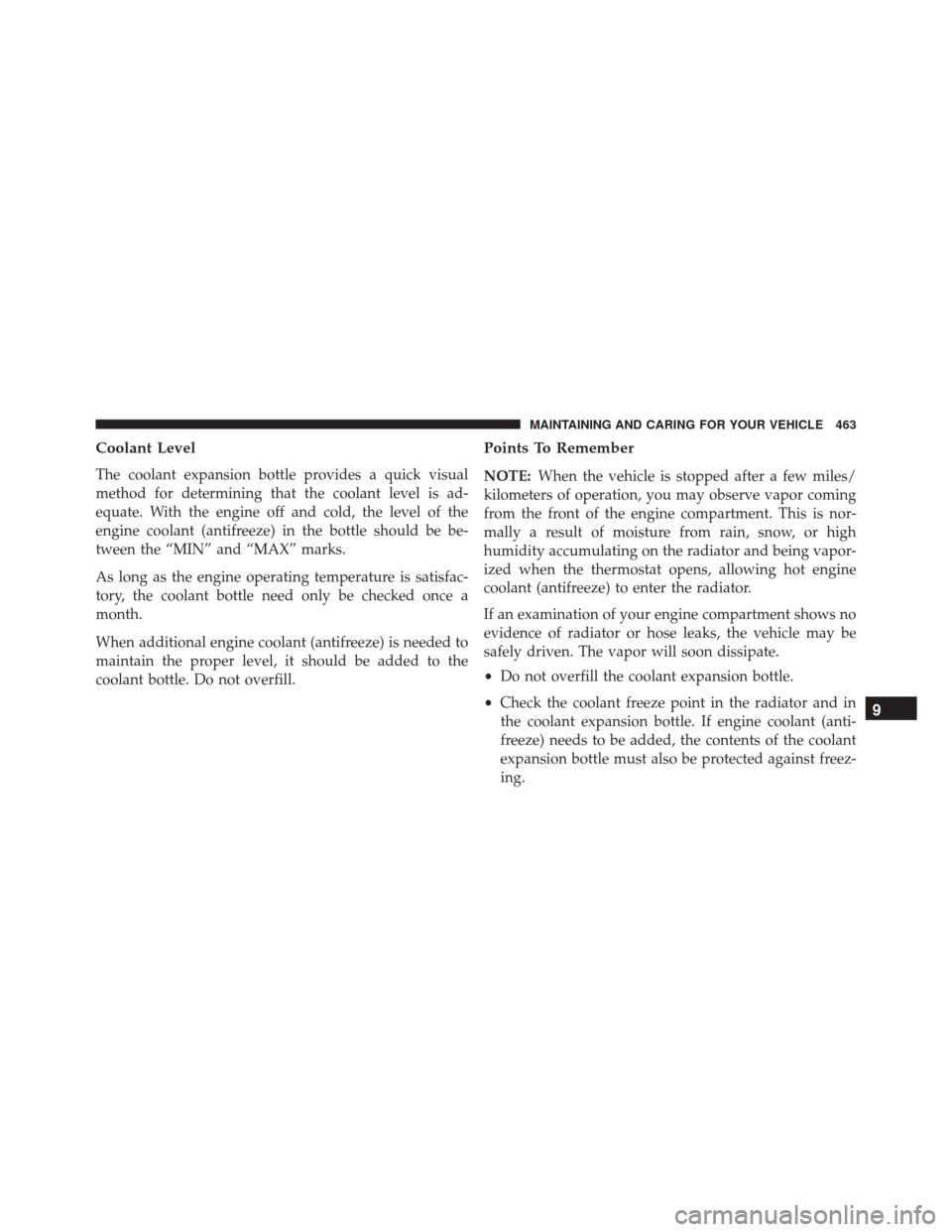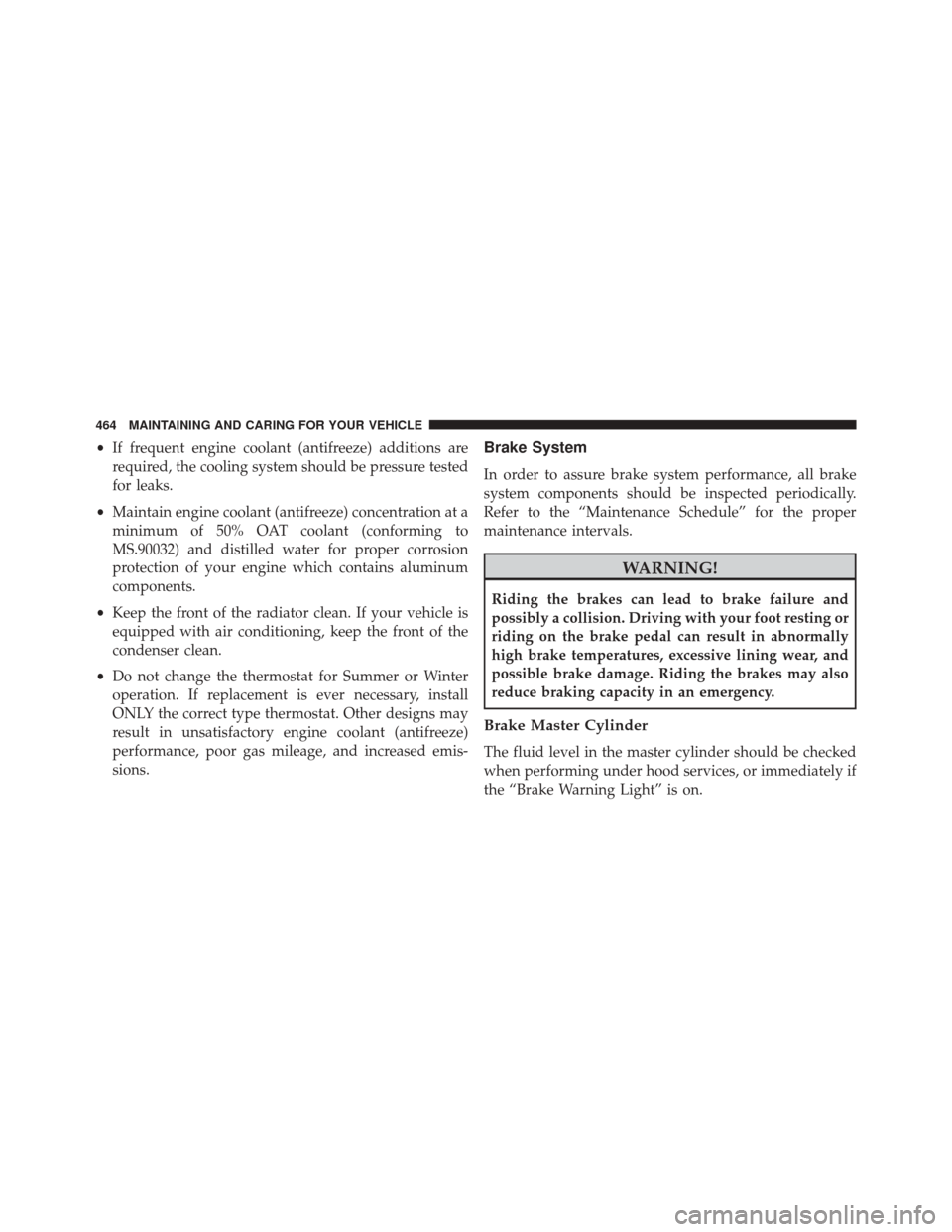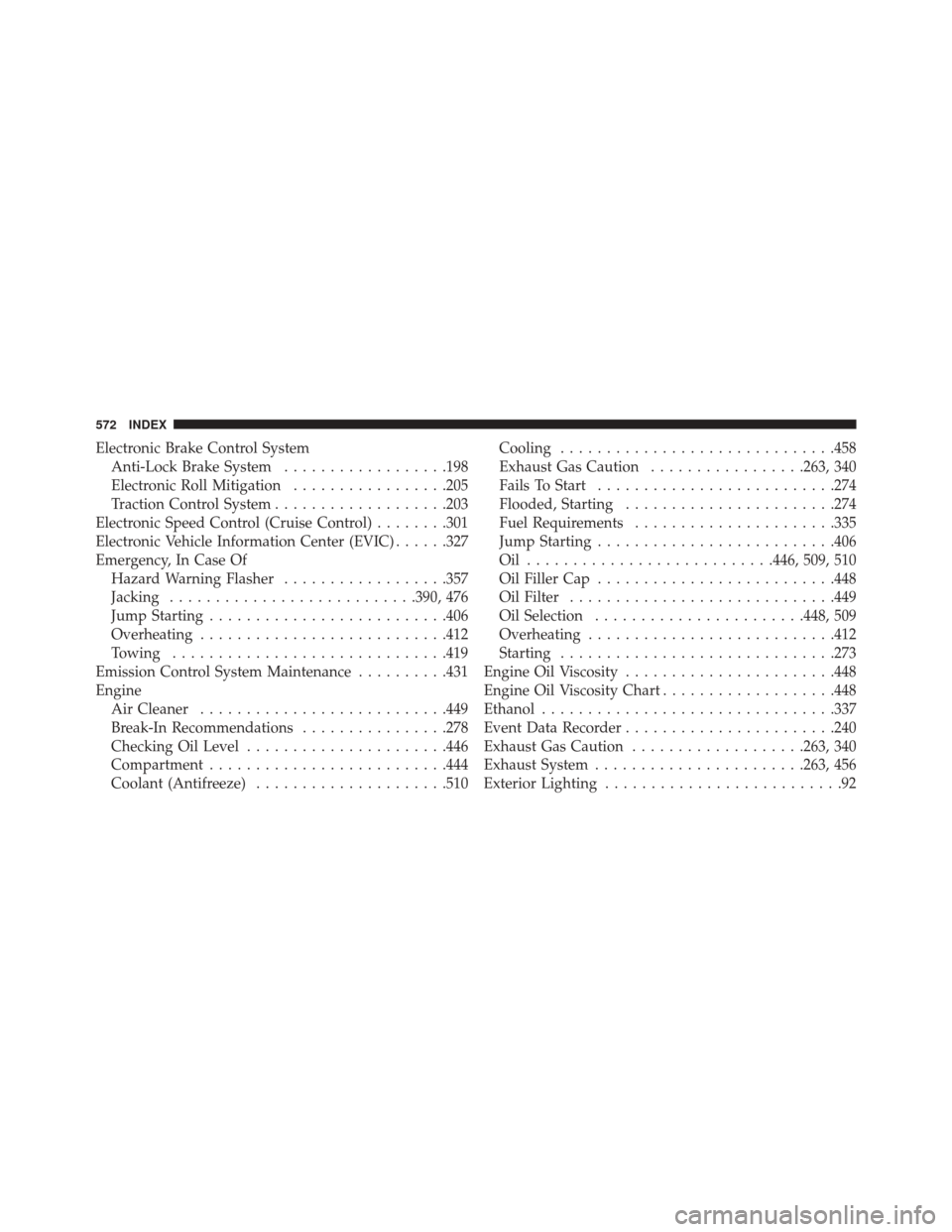Page 464 of 587

Cooling System Pressure Cap
The cap must be fully tightened to prevent loss of engine
coolant (antifreeze) and to ensure that engine coolant
(antifreeze) will return to the radiator from the coolant
recovery tank.
The cap should be inspected and cleaned if there is any
accumulation of foreign material on the sealing surfaces.
WARNING!
•Do not open hot engine cooling system. Never add
engine coolant (antifreeze) when the engine is
overheated. Do not loosen or remove the cap to cool
an overheated engine. Heat causes pressure to
build up in the cooling system. To prevent scalding
or injury, do not remove the pressure cap while the
system is hot or under pressure.
(Continued)
WARNING! (Continued)
•Do not use a pressure cap other than the one
specified for your vehicle. Personal injury or en-
gine damage may result.
Disposal Of Used Engine Coolant
Used ethylene glycol-based engine coolant (antifreeze) is
a regulated substance requiring proper disposal. Check
with your local authorities to determine the disposal
rules for your community. To prevent ingestion by ani-
mals or children, do not store ethylene glycol-based
engine coolant in open containers or allow it to remain in
puddles on the ground. If ingested by a child or pet, seek
emergency assistance immediately. Clean up any ground
spills immediately.
462 MAINTAINING AND CARING FOR YOUR VEHICLE
Page 465 of 587

Coolant Level
The coolant expansion bottle provides a quick visual
method for determining that the coolant level is ad-
equate. With the engine off and cold, the level of the
engine coolant (antifreeze) in the bottle should be be-
tween the “MIN” and “MAX” marks.
As long as the engine operating temperature is satisfac-
tory, the coolant bottle need only be checked once a
month.
When additional engine coolant (antifreeze) is needed to
maintain the proper level, it should be added to the
coolant bottle. Do not overfill.
Points To Remember
NOTE:When the vehicle is stopped after a few miles/
kilometers of operation, you may observe vapor coming
from the front of the engine compartment. This is nor-
mally a result of moisture from rain, snow, or high
humidity accumulating on the radiator and being vapor-
ized when the thermostat opens, allowing hot engine
coolant (antifreeze) to enter the radiator.
If an examination of your engine compartment shows no
evidence of radiator or hose leaks, the vehicle may be
safely driven. The vapor will soon dissipate.
• Do not overfill the coolant expansion bottle.
• Check the coolant freeze point in the radiator and in
the coolant expansion bottle. If engine coolant (anti-
freeze) needs to be added, the contents of the coolant
expansion bottle must also be protected against freez-
ing.
9
MAINTAINING AND CARING FOR YOUR VEHICLE 463
Page 466 of 587

•If frequent engine coolant (antifreeze) additions are
required, the cooling system should be pressure tested
for leaks.
• Maintain engine coolant (antifreeze) concentration at a
minimum of 50% OAT coolant (conforming to
MS.90032) and distilled water for proper corrosion
protection of your engine which contains aluminum
components.
• Keep the front of the radiator clean. If your vehicle is
equipped with air conditioning, keep the front of the
condenser clean.
• Do not change the thermostat for Summer or Winter
operation. If replacement is ever necessary, install
ONLY the correct type thermostat. Other designs may
result in unsatisfactory engine coolant (antifreeze)
performance, poor gas mileage, and increased emis-
sions.Brake System
In order to assure brake system performance, all brake
system components should be inspected periodically.
Refer to the “Maintenance Schedule” for the proper
maintenance intervals.
WARNING!
Riding the brakes can lead to brake failure and
possibly a collision. Driving with your foot resting or
riding on the brake pedal can result in abnormally
high brake temperatures, excessive lining wear, and
possible brake damage. Riding the brakes may also
reduce braking capacity in an emergency.
Brake Master Cylinder
The fluid level in the master cylinder should be checked
when performing under hood services, or immediately if
the “Brake Warning Light” is on.
464 MAINTAINING AND CARING FOR YOUR VEHICLE
Page 511 of 587
FLUID CAPACITIES
U.SMetric
Fuel (Approximate)
1.4L Turbo/2.4L Engine 12.7 Gallons48 Liters
Engine Oil With Filter
1.4L Turbo Engine (SAE 5W-40 Synthetic, API Certified) 4.0 Quarts 3.8 Liters
2.4L Engine (SAE 0W-20, API Certified) 5.5 Quarts5.2 Liters
Cooling System *
1.4L Turbo Engine (MOPAR Antifreeze/Engine Coolant 10
Year/150,000 Mile Formula) 5.5 Quarts
5.2 Liters
2.4L Engine (MOPAR Antifreeze/Engine Coolant 10 Year/
150,000 Mile Formula) 6.8 Quarts
6.5 Liters
* Includes heater and coolant recovery bottle filled to MAX level.
10
TECHNICAL DATA 509
Page 512 of 587

FLUIDS, LUBRICANTS, AND GENUINE PARTS
Engine
ComponentFluid, Lubricant, or Genuine Part
Engine Coolant We recommend you use MOPAR Antifreeze/Coolant 10 Year/150,000 Mile
Formula OAT (Organic Additive Technology) or equivalent meeting the
requirements of FCA Material Standard MS.90032.
Engine Oil – 1.4L Turbo Engine We recommend you use SAE 5W-40 API Certified Synthetic Engine Oil, meeting the requirements of FCA US Material Standard MS-12991. Refer to
your engine oil filler cap for correct SAE grade.
Engine Oil – 2.4L Engine We recommend you use SAE 0W-20 API Certified Engine Oil, meeting the
requirements of FCA US Material Standard MS-6395. Refer to your engine oil
filler cap for correct SAE grade.
Engine Oil Filter We recommend you use a MOPAR Engine Oil Filter.
Spark Plugs We recommend you use MOPAR Spark Plugs.
Fuel Selection – 1.4L Turbo Engine91 Octane Recommended, 87 Acceptable, 0-15% Ethanol.
Fuel Selection – 2.4L Engine 87 Octane, 0-15% Ethanol.
510 TECHNICAL DATA
Page 570 of 587

About Your Brakes....................... .197
Adding Engine Coolant (Antifreeze) ............460
Adding Fuel ............................ .340
Adding Washer Fluid ..................... .455
Additives, Fuel .......................... .338
AirBag ............................... .224
Advance Front Air Bag ................224, 225
Air Bag Operation ...................... .227
Air Bag Warning Light ...................237
Driver Knee Air Bag .....................228
Event Data Recorder (EDR) ................240
FrontAirBag ......................... .224
If A Deployment Occurs ..................234
Knee Impact Bolsters .....................228
Maintaining Your Air Bag System ............239
Redundant Air Bag Warning Light ...........239
Side Air Bags ......................... .228
Transporting Pets ...................... .262
Air Bag Deployment ...................... .224Air Bag Light
........................ .237, 264
Air Bag Maintenance ...................... .239
Air Cleaner, Engine (Engine Air Cleaner Filter) . . . .449
Air Conditioner Maintenance ..........113,126, 451
Air Conditioning ..................... .109, 124
Air Conditioning Controls ...................109
Air Conditioning Filter .....................452
Air Conditioning Refrigerant ..............451, 452
Air Conditioning System .................109, 451
Air Pressure, Tires ........................ .490
Air Recirculation ......................113,123
Alarm Arm The System ........................50
All Wheel Drive (AWD) .....................305
Alterations/Modifications, Vehicle ...............7
Antifreeze (Engine Coolant) ...............459, 509
Disposal ............................. .462
Anti-Lock Brake System (ABS) ................198
Appearance
Care ........................ .469
568 INDEX
Page 573 of 587

Cooling System.......................... .458
Adding Coolant (Antifreeze) ...............460
Coolant Capacity ...................... .509
Coolant Level ..................... .458, 463
Disposal Of Used Coolant .................462
Drain, Flush, And Refill ...................459
Inspection ........................... .463
Points To Remember ..................462, 463
Pressure Cap ......................... .462
Selection Of Coolant (Antifreeze) ......459, 509, 510
Corrosion Protection ...................... .469
Cupholders ............................ .153
Customer Assistance ........................10
Customer Programmable Features .............517
Data Recorder, Event ...................... .240
Daytime Running Lights .....................94
Dealer Service ........................... .432
Defroster, Rear Window ..............106, 112, 125 Defroster, Windshield
................111, 124, 265
Dimmer Switch, Headlight ...................95
Disabled Vehicle Towing ....................419
Disposal Antifreeze (Engine Coolant) ................462
Door Locks Door Locks ............................52
KeyFob...............................52
Remote ...............................52
Remote Keyless Entry (RKE) ................52
Driver’s Seat Back Tilt .......................64
Driving Through Flowing, Rising, Or Shallow Standing
Water ............................... .347
Electrical Outlet, Auxiliary (Power Outlet) ........147
Electric Park Brake ....................... .279
Electric Parking Brake ..................... .279
12
INDEX 571
Page 574 of 587

Electronic Brake Control SystemAnti-Lock Brake System ..................198
Electronic Roll Mitigation .................205
Traction Control System ...................203
Electronic Speed Control (Cruise Control) ........301
Electronic Vehicle Information Center (EVIC) ......327
Emergency, In Case Of Hazard Warning Flasher ..................357
Jacking .......................... .390, 476
Jump Starting ......................... .406
Overheating .......................... .412
Towing ............................. .419
Emission Control System Maintenance ..........431
Engine Air Cleaner .......................... .449
Break-In Recommendations ................278
Checking Oil Level ..................... .446
Compartment ......................... .444
Coolant (Antifreeze) .....................510 Cooling
............................. .458
Exhaust Gas Caution .................263, 340
Fails To Start ......................... .274
Flooded, Starting ...................... .274
Fuel Requirements ..................... .335
Jump Starting ......................... .406
Oil .......................... .446, 509, 510
Oil Filler Cap ......................... .448
Oil Filter ............................ .449
Oil Selection ...................... .448, 509
Overheating .......................... .412
Starting ............................. .273
Engine Oil Viscosity ...................... .448
Engine Oil Viscosity Chart ...................448
Ethanol ............................... .337
Event Data Recorder ...................... .240
Exhaust Gas Caution ...................263, 340
Exhaust System ...................... .263,
456
Exterior Lighting ..........................92
572 INDEX